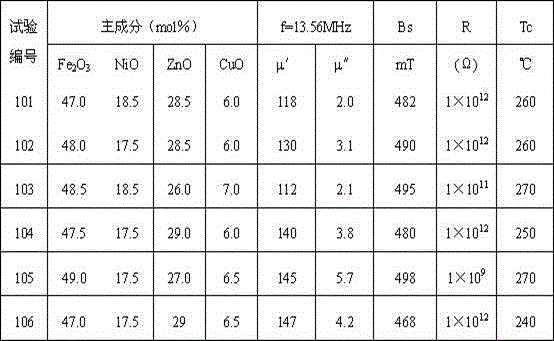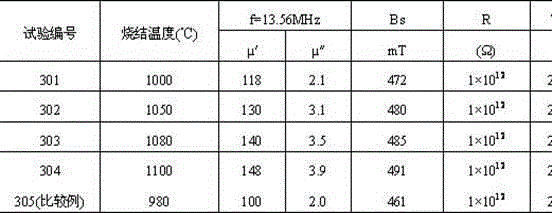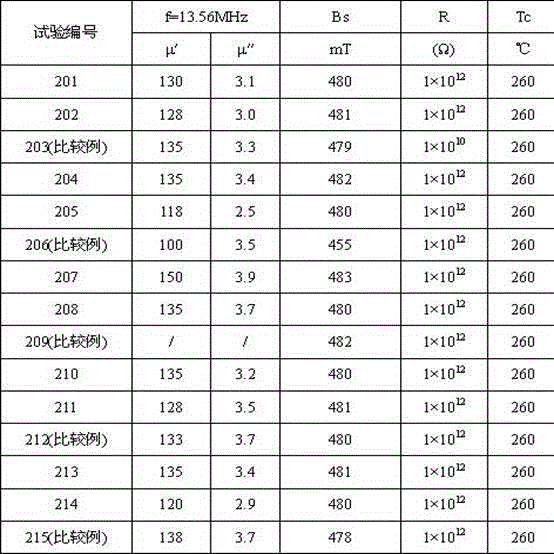Soft-magnetic nickel-copper-zinc ferrite material and preparation method thereof
A nickel-copper-zinc ferrite and soft magnetic technology, applied in the field of soft magnetic nickel-copper-zinc ferrite materials and their preparation, can solve problems such as large loss, and achieve the effects of low loss, simple preparation process and high Curie temperature
- Summary
- Abstract
- Description
- Claims
- Application Information
AI Technical Summary
Problems solved by technology
Method used
Image
Examples
Embodiment 1
[0034] Weigh Fe with the main component content shown in Table 1 2 o 3 , NiO, ZnO and CuO raw materials, relative to the total weight of the main components, the weight percentage content of the secondary components in terms of their respective standards is: MnO: 0.30%, Bi 2 o 3 : 0.3%, Co 2 o 3 : 0.5%, Mo 2 o 3 : 0.1%, SiO 2 : 0.2%, subcomponent manganese oxide MnO and Mn 3 o 4 Add in the form of raw materials, mix and vibrate the raw materials of the main component and each auxiliary component, and then pre-fire in an air kiln at 950°C for 120 minutes to obtain pre-fired powder after preliminary reaction. Coarsely crush the calcined powder until the average particle size of the particles is 1-15μm, and then use the casting process to prepare the ferrite blank (thin-film magnetic core, a magnetic core with a length×width×height of 100mm×100mm×0.1mm) , put the blank in an air kiln at 1050° C. for sintering, and the holding time is 120 minutes to obtain the soft magnet...
Embodiment 2
[0040] The preparation process, test instruments and test conditions of the magnetic core are the same as those in Example 1. Only Fe in the main ingredient formula 2 o 3 , NiO, ZnO, CuO content fixed at 48.0mol% Fe 2 o 3 , 17.5 mol% NiO, 28.5 mol% ZnO and 6 mol% CuO. The contents of subcomponents are shown in Table 2. The test results are shown in Table 3.
[0041]
[0042] Table 2
[0043]
[0044] table 3
[0045]
[0046] Note: The test value " / " of μ' in 209 (comparative example) indicates that its value has infinitely tended to 1, so the test value of μ" has no practical significance.
[0047] As can be seen from Table 2 and Table 3, when the content of secondary components is within the scope of the present invention, the complex magnetic permeability μ " is low. The saturation magnetic flux density Bs at 25°C is above 480mT; the magnetic permeability μ at 13.56MHz ′=130±25%, μ″≤4, surface resistance R>10 9 Ω, Curie temperature Tc >250°C. When the conte...
Embodiment 3
[0049] The composition of the magnetic core is the same as that of the test number 102#, and the preparation process, test instruments and test conditions are the same as those in Example 1. Only the sintering temperature is shown in Table 4.
[0050] Table 4
[0051]
[0052] It can be seen from Table 4 that when the sintering temperature is 1050-1100°C, the performance indicators of the magnetic core are better, and the temperature is lower when sintering at 980°C, resulting in the magnetic permeability μ′ and complex magnetic permeability μ ", saturation magnetic flux density Bs, surface resistance R, Curie temperature Tc in one or several performance indicators become worse.
PUM
| Property | Measurement | Unit |
|---|---|---|
| particle size | aaaaa | aaaaa |
| Curie point | aaaaa | aaaaa |
Abstract
Description
Claims
Application Information
 Login to View More
Login to View More - Generate Ideas
- Intellectual Property
- Life Sciences
- Materials
- Tech Scout
- Unparalleled Data Quality
- Higher Quality Content
- 60% Fewer Hallucinations
Browse by: Latest US Patents, China's latest patents, Technical Efficacy Thesaurus, Application Domain, Technology Topic, Popular Technical Reports.
© 2025 PatSnap. All rights reserved.Legal|Privacy policy|Modern Slavery Act Transparency Statement|Sitemap|About US| Contact US: help@patsnap.com



